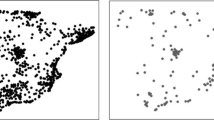Abstract
In this paper, the problem of determining the location and quality of new facilities in a network market is analyzed. Customers make their choice according to an attraction function, which is directly proportional to the facility quality level and decreasing with respect to the distance between customers and facilities. In order to solve the location problem, both an integer linear program and an exact algorithm are proposed. These algorithms are embedded into a branch and bound-based algorithm for solving the joint location–quality problem. An illustrative example where customers present different distance perception is presented.










Similar content being viewed by others
References
B.O.C. (1994) Decreto 219/1994, de 28 de octrubre, no. 140, de 6 de noviembre
Benati S, Laporte G (1994) Tabu search algorithms for the \((r|X_{p})\)-medianoid and \((r|p)\)-centroid problems. Locat Sci 2(4):193–204
Berman O, Krass D (2002) Locating multiple competitive facilities: spatial interaction models with variable expenditures. Ann Oper Res 111:197–225
Berman O, Krass D, Drezner Z (2003) The gradual covering decay location problem on a network. Eur J Oper Res 151:474–480
Berman O, Drezner Z, Krass D (2010) Generalized coverage: new developments in covering location models. Comput Oper Res 37:1675–1687
Chiang AC (2006) Fundamental methods of mathematical economics. McGraw-Hill, New York
Dasci A, Eiselt HA, Laporte G (2002) On the \((r|X_{p})\)-medianoid problem on a network with vertex and edge demands. Ann Oper Res 111:271–278
Drezner T (1994a) Locating a single new facility among existing unequally attractive facilities. J Reg Sci 34(2):237–252
Drezner T (1994b) Optimal continuous location of a retail facility, facility attractiveness, and market share: an interactive model. J Retail 70(1):49–64
Drezner T, Drezner Z, Salhi Z (2002) Solving the multiple competitive facilities location problem. Eur J Oper Res 142:138–151
Eiselt HA, Laporte G (1988a) Location of a new facility in the presence of weights. Asia-Pac J Oper Res 5:160–165
Eiselt HA, Laporte G (1988b) Trading areas of facilities with different sizes. Rech Opérationnelle/Oper Res 22(1):33–44
Eiselt HA, Laporte G (1989) The maximum capture problem in a weighted network. J Reg Sci 29(3):433–439
Eiselt HA, Laporte G (1996) Secuential location problems. Eur J Oper Res 96:217–231
Eiselt HA, Laporte G, Pederzoli G (1989) Optimal sizes of facilities on a linear market. Math Comput Model 12(1):97–103
Fotheringhan AS, O’Kelly ME (1989) Spatial interaction models: formulations and applications. Kluwer, Dordrecht
Ghosh A, Craig CS (1983) Formulating retail location strategy in a changin environment. J Mark 47:56–68
Hakimi SL (1983) On locating new facilities in a competitive environment. Eur J Oper Res 12:29–35
Hansen P, Peeters D, Thisse JF (1995) The profit-maximizing Weber problem. Locat Sci 3(2):67–85
Hansen P, Peeters D, Thisse JF (1997) Facility location under zone pricing. J Reg Sci 37(1):1–22
Hooker JN, Garfinkel RS, Chen CK (1991) Finite dominating sets for network location problems. Oper Res 39(1):100–118
Horst R, Tuy H (1993) Global optimization, deterministic approaches, 2nd edn. Springer, Berlin
Huff DL (1964) Defining and estimating a trading area. J Mark 38:34–38
Peeters PH, Plastria F (1998) Discretization results for the Huff and Pareto-Huff competitive location models on networks. TOP 6(2):247–260
Pelegrín B, Suárez-Vega R, Cano S (2012) Isodistant points in competitive network facility location. TOP 20(3):639–660
Plastria F (1992) GBSSS: the generalized big square small square method for planar single-facility location. Eur J Oper Res 62:163–174
Plastria F (1997) Profit maximising single competitive facility location in the plane. Stud Locat Anal 11:115–126
Plastria F, Carrizosa E (2001) Locating and design of a competitive facility for profit maximisation. Optimization Online, http://www.optimization-online.org/DB_HTML/2003/01/591.html
Redondo, JL, Fernández, J, García, I, Ortigosa, PM (2009) Solving the multiple competitive facilities location and design problem on the plane. Evolut Computation 17(1): 21–53
Reilly WJ (1929) Methods for study of retail relationship. University of Texas, Bureau of Business Research, Research Monograph, vol 4
ReVelle C (1986) The maximum capture or “ sphere of influence” location problem: Hotelling revisited on a network. J Reg Sci 26(2):343–358
Roy JR, Thill JC (1992) Competitive strategies for multi-establishment firms. Econ Geogr 68:290–309
Roy JR, Thill JC (1997) Multi-outlet firms, competition and market segmentation strategies. Reg Sci Urban Econ 27:67–86
Roy JR, Thill JC (2000) Network competition and branch differentiation with consumer heterogeneity. Ann Reg Sci 34:451–468
Roy JR, Thill JC (2004) Spatial interaction modeling. Papers Reg Sci 83:339–361
Sen A, Smith TE (1995) Gravity models of spatial interaction behavior. Springer, Berlin
Serra D, Colomé R (2001) Consumer choice and optimal locations models: formulations and heuristics. Paper Reg Sci 8(4):439–464
Serra D, Marianov V, ReVelle C (1992) The maximum-capture hierarchical location problem. Eur J Oper Res 62:363–371
Serra D, ReVelle C (1995) Competitive location in discrete space. In: Drezner Z (ed) Facility location: a survey of applications and methods. Springer, Berlin, pp 367–386
Suárez-Vega R, Santos-Peñate DR, Dorta-González P (2004a) Competitive multifacility location on networks: the (\(r|X_{p}\))-medianoid problem. J Reg Sci 44(3):569–588
Suárez-Vega R, Santos-Peñate DR, Dorta-González P (2004b) Discretization and resolution of the (\(r|X_{p} \))-medianoid problem involving quality criteria. TOP 12(1):111–133
Acknowledgments
Partially financed by the Ministerio de Educación y Ciencia and FEDER, grant MTM2005-09362.
Author information
Authors and Affiliations
Corresponding author
Rights and permissions
About this article
Cite this article
Suárez-Vega, R., Santos-Peñate, D.R. & Dorta-González, P. Location and quality selection for new facilities on a network market. Ann Reg Sci 52, 537–560 (2014). https://doi.org/10.1007/s00168-014-0598-0
Received:
Accepted:
Published:
Issue Date:
DOI: https://doi.org/10.1007/s00168-014-0598-0




